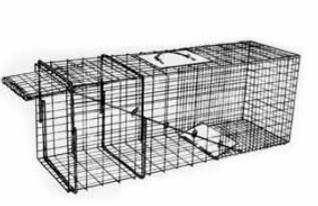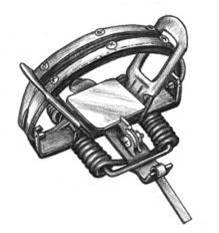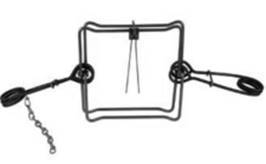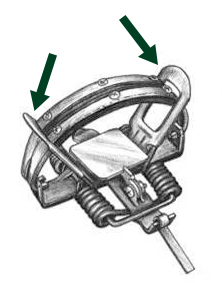Regulated Trapping

Keeping Maine's Wildlife healthy.
In conjunction with hunting, regulated trapping is an important wildlife management tool. It helps maintain healthy, abundant wildlife populations, allows habitats to thrive and provide ample food, and keeps a balance between wildlife populations and people. Regulated trapping does not cause wildlife species to become endangered or extinct. In fact, without it, some wildlife populations would grow too large for their own good – which can lead to increased disease (mange and rabies), starvation, and conflicts with people. Overpopulation of certain species can also prove detrimental to other species such as ground nesting birds and other wildlife.
Trapping is scientifically managed by Maine Department of Inland Fisheries and Wildlife’s wildlife biologists and these regulations are enforced by game wardens. Read on to learn more about the benefits of trapping and how MDIFW ensures that it is done responsibly, including the types of traps allowed, season dates, which species can be trapped, and more.
I want to...
Learn how trapping is regulated + helps keep wildlife populations healthy
View trapping laws and regulations
The Benefits of Trapping
Regulated trapping benefits wildlife species, habitats, and human neighbors alike.
Healthier wildlife populations
Wildlife populations cannot increase indefinitely. When populations get too numerous for the environment to support them, they become more prone to starvation (due to limited food sources), and to outbreaks of diseases like rabies, distemper, mange, and parvovirus. They can also start to damage their habitat and negatively impact other species.
Regulated trapping helps keep wildlife populations at levels that their surrounding environment can support. It also provides wildlife biologists with valuable data for disease prevention, species management, and population monitoring.
Implications of a Ban on Trapping: the Massachusetts Experience (PDF)
Management and protection of endangered species
Regulated trapping can help restore threatened and endangered species by controlling abundant predators and other animals that would otherwise have killed them or destroyed their habitats. For example, trapping protects piping plovers, least terns, and other rare species from predation and nest loss, caused by foxes and raccoons.
Modern-day traps are humane and selective, meaning that they are designed to capture certain species while avoiding most others.
Reduced human and wildlife conflicts
Human-wildlife interactions are becoming more frequent due to a variety of social and ecological factors. The first is food: many species are attracted to and thrive near people because of the easy access to abundant food sources (think bird feeders, pet foods, garbage bins outside and at the edge of the road on pick-up day, dumpsters with easy-to-open lids, and grills with leftover scraps). The second factor is predation: some species seek refuge near people, while others may be drawn into backyards to hunt for prey (e.g., bobcat hunting squirrels near bird feeders).
These factors often result in wildlife living closer than many human neighbors prefer. The Department continues to promote living responsibly with wildlife and how to remove and secure common attractants. Hunting and trapping help by maintaining healthy population levels that are less likely to go beyond what most people are going to tolerate (social carrying capacity) and become a challenge for humans.
Funding of wildlife conservation
Revenues from trapping licenses are used for wildlife conservation projects, habitat enhancement, land acquisition, and more. All of Maine’s wildlife benefit from these funds, including species that are not hunted or trapped, such as songbirds, Canada lynx, and New England cottontail.
Food and other byproducts
Maine trappers are known to be resourceful, always utilizing what they have and using as much of their harvest as possible. Some furbearer species, such as beaver, provide families with a local food source of high quality protein; and the superior warmth, beauty, and long-lasting durability of fur garments makes it a mainstay in many northern communities. Other byproducts, including soaps and perfumes, or fat/oils for leather goods ensure that no part goes to waste.
Species expertise
Trapping also cultivates a group of experts with unique skillsets and technical expertise for species many people don’t even know exist. Trappers are experienced, knowledgeable, and passionate about wildlife. Regulated trapping allows the use of an abundant species that also maintains species on the landscape for viewing opportunities. Maine trappers have advanced our knowledge of furbearers and continue to provide important data for scientific studies. Recent examples include biological samples to track age and sex of the harvest, ticks on carnivores, intestinal parasites in canids, genetic samples for multiple studies, canine distemper and rodenticides in fisher, and unique observations that aid in the surveillance of diseases and parasites.
Trapping helps keep wildlife populations healthy + provides wildlife biologists with valuable data for disease prevention, species management, and population monitoring.
How is trapping regulated?
Like hunting and fishing, trapping is regulated by Maine Department of Inland Fisheries and Wildlife and enforced by Maine’s dedicated game wardens.
The first step toward obtaining a Maine trapping license is to complete a trapper education course and pass a written exam demonstrating an understanding of species ecology, furbearer management, trap setting, animal handling, landowner relations, and trapping laws. Trappers must also purchase a license; these funds contribute to the conservation and management of all wildlife.
Trapping is managed through scientifically based regulations that include the types of traps that can be used, the frequency at which they must be checked, and the steps trappers must take to prevent the capture of non-target species. MDIFW continually reviews and updates those regulations, as well as our education programs and capture methods, to ensure the humaneness of trapping. We also set trapping seasons during the colder months when pelts are thickest and avoid the time of year when animals have dependent young.
Looking back…
From the beginning of time, the hunting and trapping of animals for food and clothing has been key to our survival. When Europeans first colonized North America, they found a land rich in furbearing mammals. Beavers were so valuable that their pelts became currency and were traded for goods and services. Beaver felt hats were not only fashionable, but warm and durable. During the 1700s and 1800s, they became so popular that beaver populations were extirpated in some areas. At the time, wildlife seemed endless and there were no regulations on hunting or trapping.
Trapping has evolved significantly since then, with modern day trapping following the North American Model of Wildlife Conservation (PDF). No species in the U.S. have become endangered or extinct due to regulated trapping. Although the number of active trappers has declined, there is still a sizable group of people interested in trapping for the benefits of an outdoor lifestyle—there are approximately 4,200 licensed trappers in Maine, with approximately half of them active each year. Trappers today are of all ages and backgrounds, each sharing a desire to connect with Maine's natural resources and live a sustainable outdoor lifestyle.
State wildlife agencies continually review and develop rules, regulations, education programs, and capture methods that consider animal welfare.
What kinds of traps are used?
MDIFW is involved in developing the Best Management Practices (BMPs) for Trapping. This is a major national project in cooperation with other states, the U.S. Department of Agriculture, trappers’ associations, and experienced veterinarians to evaluate various traps. This program has established high standards for the efficiency, selectivity, practicality, and humaneness of modern-day trapping and the various traps involved. Wildlife biologists and trappers support BMPs because they share a passion for the welfare of wildlife.
In Maine, there are two kinds of traps: restraining devices and lethal traps.
Restraining devices include foothold and box/cage traps. Foothold traps hold an animal's foot but are not designed to injure them. In fact, our biologists use many of these traps to catch, research, and release many Maine species, such as Canada lynx, unharmed.
Lethal traps kill the target species quickly and humanely. They are located in specific areas that are away from people and avoid non-target species, such as underwater or enclosed in an exclusion device. A common lethal trap is a body-gripping trap, which operates like a mouse trap to kill an animal quickly.
Example trap types (Courtesy of Association of Fish & Wildlife Agencies)



Read more:
Which species may be trapped?
Only abundant furbearer species can be trapped. The furbearer category includes mammals ranging in size from weasels to bobcats. Some furbearers, including coyote, red fox, gray fox, bobcat, opossum, raccoon, and skunk, can be both trapped and hunted during certain times of the year. A diverse group of rodents and carnivores, furbearers live on land and in the water and play beneficial predator (coyote), prey (muskrat), and keystone species (beaver) roles.
Thanks to modern-day wildlife management, many of these species are more abundant than they were 100 years ago. If you don’t typically see these species, the term “abundant” can be a surprise – but by taking a few extra minutes during a hike and learning what clues to look for (such as tracks in the dirt or chew marks on a branch), and sounds to listen for, you can start to see that these species really are all around us.
Read more:
Only abundant furbearer species can be trapped. Trapping does not cause wildlife to become threatened or endangered.
As a non-trapper, what should I know?
Hikers, hunters, wildlife watchers, and other outdoor enthusiasts should be aware that they are sharing the woods with trappers during trapping season, and should know what to do if they come across a trap. Trapping may be allowed on some state-owned lands like Wildlife Management Areas and on private lands by large landowners, such as the North Maine Woods. The general trapping season usually runs from early November through the end of December. Trapping seasons for some species, like beaver, are longer in certain areas of the state (mid-October though the end of April).
If you happen to come across a trap, leave it alone. Remember that trappers must have landowner permission to be there, and it is unlawful to disturb traps, disturb any wild animal caught in a trap, or shoot an animal that is caught in someone else’s trap.

In the unlikely event that your unleashed dog gets caught in a trap, follow these steps:
- Stay calm. Rest assured, foothold traps are designed to hold an animal by the foot without injuring it. The most common type of foothold trap used in Maine (including by MDIFW biologists) is shown here.
- Get help. If available, get a second person to assist you.
- Protect yourself. Some dogs may remain calm when trapped, while others may be frightened and attempt to bite, especially as the trap is removed from their foot. Protect yourself by securing the dog’s muzzle using a jacket, or by placing a barrier between yourself and the dog.
- Open the trap. If possible, position the trap flat on the ground. To open the trap, push down using your hands or feet on the levers located at either end of the jaws (see arrows in the image). This will release tension on the jaws and allow you to remove the dog’s foot.
- Respect the trapper and obey the law. It is unlawful to take or destroy a trap without permission from the owner.
- Prevent future incidents. Follow leash laws and keep your dog on a leash. If you use dogs to hunt, learn to recognize common trap sites, such as road intersections in more remote areas of the state.